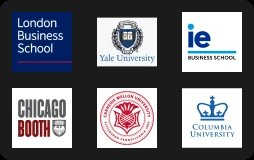
MiM in USA
MiM in USA: A Complete Guide for Indian StudentsAre you considering pursuing a
Table of Contents

If you're a recent graduate and aiming for early career growth, a Master in Management (MiM) could be your perfect next step. MiM is designed for students with minimal work experience, focusing on core business disciplines. This blog will help you understand everything about MiM, how it differs from an MBA, and why it’s a fantastic option to fast-track your management career.
So, what exactly is a Master in Management (MiM)?
It’s a comprehensive business degree that equips fresh graduates with essential management skills. Think of it as a tailored program for young professionals with little to no experience, giving you a solid business foundation. Wondering how MiM compares to an MBA? Here’s a quick breakdown.
Feature | MiM | MBA |
Who’s it for? | Recent grads (0-2 years' experience) | Professionals with 3-5+ years' experience |
Course Duration | 1-2 years | 1-2 years |
Cost | More affordable than MBA | Higher fees, especially at top schools |
Career Focus | Entry-level management roles | Senior leadership and strategic roles |
An MiM is ideal if you're just starting out and looking for a degree that offers management skills without waiting years to gain work experience. It’s also cost-effective, offering a quicker return on investment (ROI).

Curious about what you’ll study? The MiM curriculum is a balanced mix of theory and practical skills, with core business courses like finance, marketing, and organizational behavior.
Aspect | Details |
MiM Full Form | Master in Management |
Typical Course Duration | 1-2 years |
Subjects Covered | Finance, Marketing, Organizational Behavior, Strategy |
Study Modes | Full-time, Part-time, Online |
You’ll study these subjects through lectures, case studies, group projects, and often capstone projects or internships that let you apply your knowledge in real-world settings.
Here's a snapshot of what you can expect in terms of core subjects and companies hiring MiM graduates:
Electives and Specializations
MiM programs allow you to choose electives like Data Analytics, Digital Marketing, or Entrepreneurship, so you can focus on what interests you most. It’s a flexible way to customize your degree.
Still deciding between an MiM, MBA, or another management degree? Here’s a quick comparison:
Degree | MiM | MBA | Master’s in Finance |
Duration | 1-2 years | 1-2 years | 1 year |
Target Audience | Recent grads | Experienced professionals | Finance specialists |
Cost | Lower | Higher | Moderate |
Career Focus | General management | Leadership and strategy | Finance-specific roles |
An MiM is ideal if you’re just starting out in the professional world and looking for a broader business education. For those more advanced in their careers, an MBA might offer better leadership training, while a Master’s in Finance is the go-to for those aiming to specialize solely in finance.

The good news is, MiM programs are typically designed for recent graduates, so no work experience is required. However, top schools often have competitive entry requirements like a strong academic background and GMAT/GRE scores.
Country | Top Schools | Eligibility Requirements |
USA | MIT Sloan, Duke Fuqua | Bachelor’s degree, GMAT/GRE, TOEFL for non-native speakers |
UK | London Business School, Warwick | GMAT optional, 3-year undergraduate degree required |
France | HEC Paris, ESCP | GMAT, English proficiency tests (TOEFL/IELTS) |
Some schools also accept alternative admissions tests or waive the GMAT for students with strong academic or professional backgrounds, so always check with the programs you’re interested in.
MiM programs are offered by top business schools all over the world, each bringing its own unique strengths.
Here’s a detailed table outlining the top 10 global MiM programs, including ranking, fees, GMAT/GRE requirements, and eligibility criteria based on the most current 2024 data:
University | Global Rank (2024) | Tuition Fees (Approx) | GMAT/GRE | Eligibility |
HEC Paris | 1 | €53,200 | GMAT: 690 | Bachelor’s degree, 0-2 years work experience, IELTS/TOEFL |
University of St. Gallen | 2 | €7,500 | GMAT: 650 | Bachelor’s degree, high GPA, English proficiency |
INSEAD | 3 | €52,500 | GMAT: 710 | Bachelor’s degree, no minimum GPA, IELTS/TOEFL |
London Business School | 4 | £47,500 | GMAT: 600 | Bachelor’s degree, 0-2 years work experience, IELTS/TOEFL |
ESSEC Business School | 5 | €39,000 | GMAT: 640 | Bachelor’s degree, strong academic record, English proficiency |
ESCP Europe | 6 | €25,800 | GMAT optional | Bachelor’s degree, work experience preferred, IELTS/TOEFL |
ESADE Business School | 7 | €35,000 | GMAT: 670 | Bachelor’s degree, 0-2 years work experience, English proficiency |
IE Business School | 8 | €43,300 | GMAT: 650 | Bachelor’s degree, personal interview, English proficiency |
EDHEC Business School | 9 | €21,000 | GMAT optional | Bachelor’s degree, work experience preferred, English proficiency |
WU Vienna University | 10 | €726 per semester | GMAT optional | Bachelor’s degree, 0-2 years work experience, IELTS/TOEFL |
In India, MiM programs are becoming more popular due to their cost-effectiveness and the rising demand for management professionals. Studying abroad offers greater international exposure, access to global companies, and stronger alumni networks.

Let’s talk about the perks of an MiM! Here are some reasons why you should consider it:
Early Career Advantage: You don’t need years of experience to jump into management roles.
Global Networking: MiM programs bring together students from around the world, helping you build valuable international connections.
Cost-Effective: Compared to MBAs, MiM programs are generally more affordable, offering a quicker return on investment.
Wondering what kind of jobs you can get after an MiM? Graduates often land roles in consulting, marketing, finance, and operations. Here’s a glimpse at salary expectations based on location:
With the right experience, many MiM grads advance to senior roles within 5-10 years, making it an excellent long-term career investment.
A PGDM (Post Graduate Diploma in Management) in India is a well-known program that helps students learn management skills, especially for working in the Indian business environment. It’s usually chosen by students with little work experience or even fresh graduates.
On the other hand, a MiM (Master in Management) abroad is designed for fresh graduates who want to gain global business knowledge. MiM programs, especially from top universities in Europe like HEC Paris or London Business School, focus on giving students an international perspective, making it ideal for those who want to work globally.
For Indian students, MiM offers a big advantage because it gives them the chance to study in an international environment, learn from global faculty, and build a diverse network of professionals from different countries. MiM graduates also have better opportunities to work in top global companies, especially in consulting or finance, which makes MiM a great choice for those looking for a career outside India.
Criteria | PGDM in India | MiM Abroad |
Target Audience | Fresh graduates or those with 1-2 years of experience | Primarily fresh graduates |
Focus | Indian business practices | Global business with international exposure |
Duration | 1-2 years | 1-2 years |
Cost | ₹10-25 lakhs | ₹30-60 lakhs |
Job Opportunities | Indian companies | Global companies, consulting, finance |
Networking | Indian network | International network |
Recognition | Strong in India | Globally recognized |
In a nutshell, the Master in Management (MiM) is a fantastic choice if you’re looking to build a strong foundation in management and leadership straight out of your bachelor’s degree. With a mix of affordability, flexibility, and global exposure, it’s a smart option for recent graduates ready to step into the business world.
Still curious? Head over to MastersBuddy and explore the top MiM programs around the world. Whether you’re looking for the best fit or need guidance with your application, MastersBuddy is here to help you on your MiM journey. Reach out today and take the first step toward your dream career!

